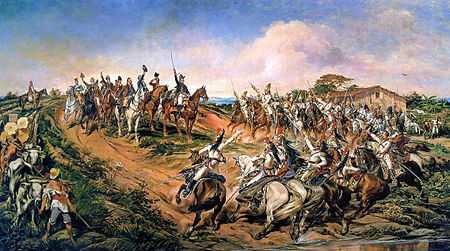Independence or Death (painting)
 | |
| Artist | Pedro Américo |
|---|---|
| Year | 1888 |
| Type | Oil on canvas |
| Dimensions | 4.15 m × 7.60 m (163 in × 299 in) |
| Location | Museu Paulista [1], São Paulo |
The painting Independence or Death (Independência ou Morte in Portuguese), also known as the Cry of Ipiranga (Grito do Ipiranga in the original), is the main artwork representing the proclamation of Brazilian independence.[2]
History
The artist Pedro Américo finished the painting in 1888 in Florence, Italy, 66 years after the proclamation of independence. The Portuguese royal house commissioned the work, due to investments into the construction of the Museu do Ipiranga (presently the Museu Paulista). The goal of the artwork was to emphasize the monarchy.[2]
Controversies
There exist evidence that the painting is not an accurate description of the events on the shores of the Ipiranga Brook.[2] Pedro Américo also is accused of having plagiarized the painting "1807, Friedland", from Ernest Meissonier, painted in 1875.[3]
_Ernest_Meissonier.jpg)
Evidences
According to historians, there exist evidence that the painting does not accurately portray the events on the day of the Cry of Ipiranga.
- Horses: Prince Pedro wasn't using horses. At the time, in long voyages, donkeys and mules were used.[2]
- Number of soldiers: Prince Pedro's travel group had few members.[2]
- Clothing: Neither Prince Pedro, nor anybody who was with him was wearing dress uniforms.[2]
- Casa do grito: The first record of the house on the background is from 1884, 62 years after the Cry of Ipiranga).[2]
- Spatial Geography: The Ipiranga Brook is in an incorrect place. It should be behind the person who is looking at the painting.[3]
- Intruder member: The painter, Pedro Américo, made a self-portrait in the painting, even though he was born many years after independence.[3]
- Travel incident: The prince regent appears on the painting to be with an triumphant demeanour, but in truth, he was feeling strong pains. He had diarrhea which, for many historians, was caused by the tiredness due to the long voyage.[3]
References
- ↑ "Quadro de Pedro Américo de Figueiredo "Independência ou Morte"". Retrieved 13 November 2013.
- ↑ 2.0 2.1 2.2 2.3 2.4 2.5 2.6 "O grito do Ipiranga aconteceu como no quadro?". uol.com.br. Retrieved 2 November 2012.
- ↑ 3.0 3.1 3.2 3.3 "O Grito do Ipiranga - VilaMulher". terra.com.br. Retrieved 2 November 2012.